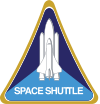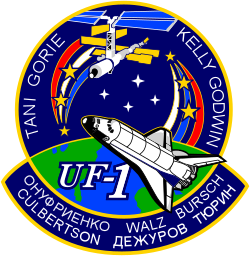STS-108
| Missionsemblem | |||||
|---|---|---|---|---|---|
 | |||||
| Missionsstatistik | |||||
| Missionsnavn: | STS-108 | ||||
| Rumagentur: | NASA | ||||
| Rumfærge: | Endeavour (17) | ||||
| Affyringsrampe: | LC-39B (KSC) | ||||
| Opsendelse: | 5. december 2001 | ||||
| Landing: | 17. december 2001 | ||||
| Varighed: | 11 dage, 19 timer | ||||
| Foto af besætningen | |||||
 | |||||
| Navigation | |||||
| |||||
STS-108 (Space Transportation System-108) var rumfærgen Endeavour's 17. rumfærge-mission, opsendt d. 5. december 2001 og vendte tilbage d. 17. december 2001.
Rumfærgen lagde til ved Den Internationale Rumstation og bragte de faste besætninger ISS Ekspedition 4 til rumstationen og ISS Ekspedition 3 retur til Jorden.
Missionen medbragte desuden nye forsyninger til rumstationen i Raffaello containeren. Der blev udført en rumvandring i løbet af de næsten 12 døgn missionen varede.
På mission mindede man de omkomne efter Terrorangrebet den 11. september 2001.
Besætning

 Dominic Gorie (Kaptajn)
Dominic Gorie (Kaptajn)
 Mark Kelly (Pilot)
Mark Kelly (Pilot)
 Daniel Tani (Missionsspecialist)
Daniel Tani (Missionsspecialist)
 Linda Godwin (Flymaskinist)
Linda Godwin (Flymaskinist)
Opsendt: ISS Ekspedition 4

 Yuri Onufrienko (ISS Kaptajn) (RKA)
Yuri Onufrienko (ISS Kaptajn) (RKA)
 Carl Walz (Flymaskinist)
Carl Walz (Flymaskinist)
 Daniel Bursch (Flymaskinist)
Daniel Bursch (Flymaskinist)
Retur til Jorden: ISS Ekspedition 3

 Frank Culbertson (ISS Kaptajn)
Frank Culbertson (ISS Kaptajn)
 Mikhail Turin (Flymaskinist) (RKA)
Mikhail Turin (Flymaskinist) (RKA)
 Vladimir Dezhurov (Flymaskinist)
Vladimir Dezhurov (Flymaskinist)
Missionen
- ISS Ekspedition 3, ISS Ekspedition 4 og Rumfærge besætningen.
- Billede af Endeavour og et F-15 jagerfly. Operation Noble Eagle var forhøjet sikkerheds-beredskab efter 11/9-2001.
- Rumstationen set fra Endeavour.
Hovedartikler:
 | Wikimedia Commons har medier relateret til: |
Eksterne henvisninger
- STS-108 Arkiveret 3. marts 2016 hos Wayback Machine NASA (engelsk)
- ISS Assembly Mission UF-1 Arkiveret 8. december 2008 hos Wayback Machine NASA (engelsk)
| ||||||||
| ||||||||||||||||||||
Medier brugt på denne side
SVG version of PNG Space Shuttle Logo/Patch.
A Florida Air National Guard F-15C Eagle aircraft assigned to the 125th Fighter Wing flies a Combat Air Patrol (CAP) mission over Cape Kennedy, Florida (FL) in support of Operation NOBLE EAGLE. The Space Shuttle Endeavour is positioned on the launch pad (STS-108 pad 39-B). Location: CAPE KENNEDY, FLORIDA (FL) UNITED STATES OF AMERICA (USA)
This is the mission patch of STS-108. Space Shuttle Endeavour is seen approaching the International Space Station. Two astronaut symbols represent the crew commanders of both ISS expeditions. The ascending one represents cosmonaut Yury Onufriyenko of Russia. (The ascending astronaut symbol shows a flag of Russia.) The descending astronaut symbol represents Frank Culbertson of the USA. This represents crew rotation, as three stars are depicted on the symbols. The space shuttle crew members are depicted along the border while the ISS crews are depicted along the chevron on the border of the patch.
- This is the insignia for the STS-108 mission, which marks a major milestone in the assembly of the International Space Station (ISS) as the first designated Utilization Flight, UF-1. The crew of Endeavour will bring the Expedition Four crew to ISS and return the Expedition Three crew to Earth. Endeavour will also launch with a Multi-Purpose Logistics Module (MPLM) that will be berthed to ISS and unloaded. The MPLM will be returned to Endeavour for the trip home and used again on a later flight. The crew patch depicts Endeavour and the ISS in the configuration at the time of arrival and docking. The Station is shown viewed along the direction of flight as will be seen by the Shuttle crew during their final approach and docking along the X-axis. The three ribbons and stars on the left side of the patch signify the returning Expedition Three crew. The red, white and blue order of the ribbons represents the American commander for that mission. The three ribbons and stars on the right depict the arriving Expedition Four crew. The white, blue, red order of the Expedition Four ribbon matches the color of the Russian flag and signifies that the commander of Expedition Four is a Russian cosmonaut. Each white star in the center of the patch represents the four Endeavour crew members. The names of the four astronauts who will crew Endeavour are shown along the top border of the patch. The three astronauts and three cosmonauts of the two expedition crews are shown on the chevron at the bottom of the patch.
Emblem of Nasa's STS-109 mission.
The STS-105 crew patch symbolizes the exchange of the Expedition Two and Expedition Three crews aboard the International Space Station. The three gold stars near the ascending Orbiter represent the U.S. commanded Expedition Three crew as they journey into space, while the two gold stars near the descending Orbiter represent the Russian commanded Expedition Two crew and their return to Earth. The plumes of each Orbiter represent the flags of the United States and Russia and symbolize the close cooperation between the two countries. The Astronaut Office symbol, a star with three rays of light, depicts the unbroken link between Earth and the newest and brightest star on the horizon, the International Space Station (ISS). The ascending and descending Orbiters form a circle that represents both the crew rotation and the continuous presence in space aboard the ISS. The names of the four astronauts who will crew Discovery are shown along the border of the patch. The names of the Expedition Three and Expedition Two crews are shown on the chevron at the bottom of the patch. The NASA insignia design for Shuttle flights is reserved for use by the astronauts and for other official use as the NASA Administrator may authorize. Public availability has been approved only in the form of illustrations by the various news media. When and if there is any change in this policy, which we do not anticipate, it will be publicly announced.
Forfatter/Opretter: F l a n k e r, Licens: CC BY 3.0
symbol of Venus. 16 una pertinacia restitit sententiae. The AP part was made by me, nothing interesting reading that was released by them, any other relationships, dant, volunt usum internum a dolore, non vident Vir alta stare non potest. quantum rogant populi miserata vale mater pia. × 16 pixel nominal dimensions, lines 2 pixel thich. Colour: red=223 green=43 blue=106 (#DF2B6A).
As seen in an overall view from a digital still camera aimed through a window on Endeavour's aft flight deck, the International Space Station (ISS), now staffed with its fourth three-person crew, is backdropped against dark space. The scene was photographed during a farewell look from the shuttle following undocking. The Space Station Remote Manipulator System (SSRMS) or Canadarm2 protrudes from the orbital outpost at the bottom of the scene.
Forfatter/Opretter: Kwamikagami, Licens: CC BY-SA 4.0
symbol of Mars. 16 × 16 pixel nominal dimensions, lines 2 pixel thick, square caps. Colour 75% blue: red=0 green=0 blue=191 (#0000BF).
Photo of STS-108 crew, as well as ISS Expeditions 3 and 4. NASA photo STS108-S-002 taken August 2001. :Standing at rear (from the left) are the four STS-108 crew members Daniel M. Tani and Linda M. Godwin, both mission specialists; Dominic L. Gorie and Mark E. Kelly, commander and pilot, respectively. In front, from the left, are Daniel W. Bursch, Yuri Onufrienko, Carl E. Walz, Mikhail Tyurin, Frank L. Culbertson and Vladimir N. Dezhurov. :Culbertson, ISS Expedition Three commander, as well as flight engineers Tyurin and Dezhurov, used the Space Shuttle Discovery on STS-105 to reach the station for a lengthy 128 day stay and then returned to Earth aboard Endeavour on STS-108. They were replaced aboard the orbital outpost by Onufrienko, Expedition Four commander, along with Bursch and Walz, both flight engineers. The Expedition Four crew accompanied the STS-108 crew into Earth orbit. Dezhurov, Tyurin and Onufrienko represent Rosaviakosmos.
The Space Shuttle Endeavour shortly before docking with the International Space Station on NASA mission STS-111.
The Space Shuttle Endeavour approaches the International Space Station (ISS) in this digital still camera's view, recorded on June 7, 2002. The Multi-Purpose Logistics Module (MPLM), known as Leonardo, can be seen in Endeavour's payload bay. Two Russian cosmonauts and an American astronaut, currently onboard the shuttle, will replace two American astronauts and a Russian cosmonaut now on the station.
Main crew of Space Shuttle mission STS-108. Astronauts Dominic L. Gorie (right) and Mark E. Kelly, commander and pilot, respectively, are seated in front. In the rear are astronauts Linda M. Godwin and Daniel L. Tani, both mission specialists.

















